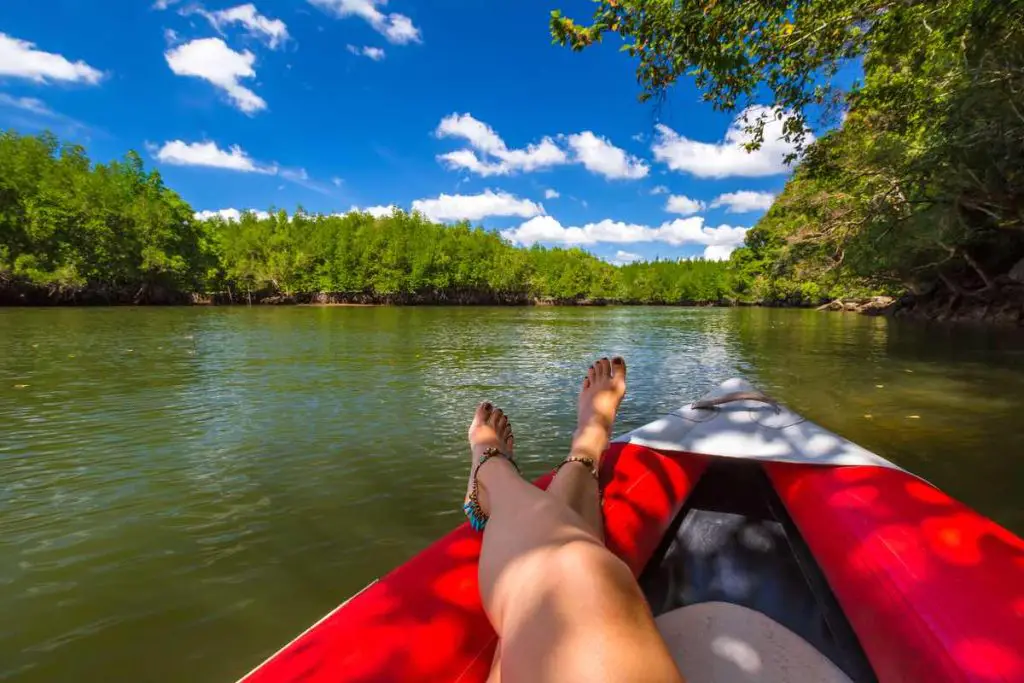Kayaking out on the water is a fun and relaxing experience until your kayak fills up with water. Fortunately, to keep from capsizing, you must pull out the universal scupper plugs you have wedged snuggly into the holes of your kayak to release the water through the scuppers. Scupper plugs are great to have for your kayak for this reason, but are all kayak scupper plugs universal?
Kayak scupper plugs are not all universal. While there are universal scupper plugs that fit several types of kayaks, there are also certain types of scupper plugs that only fit specific kayaks. Scupper plugs can come in different designs and sizes.
In this article, I will inform you if your kayak needs a specific scupper plug. I will also discuss different designs of scupper plugs and explain how to use them, as well as if all kayaks require scupper plugs.

Do You Need a Specific Size Scupper Plug for Your Kayak?
Many kayaks take universal scupper plugs; however, it’s not a one-size-fits-all. Many kayaks have to scupper holes of different shapes and sizes in the bottom, so they may require a specific size.
To find the correct size of scupper plugs, you should measure the diameter of the scupper holes on your kayak. This will help determine which size to buy and save you the trouble of buying a few different sizes until you find the perfect fit.
You want the scupper plug to fit firmly in the scupper hole but still be fairly easy to pull out when necessary. It won’t sufficiently keep water from getting into your kayak if it’s too small. If it’s too big, the scupper plugs won’t stay adequately secure in the scupper hole.
How Do You Use Scupper Plugs?
Scupper plugs are very easy to use, with the most challenging part pretty much being finding the best size for your kayak. Luckily, that’s not even that hard, as universal scupper plugs fit several kayaks. To use scupper plugs, follow these steps:
1. Plug the scupper holes on your kayak with scupper plugs to keep the water from coming up from the underside of the kayak.
2. If water finds its way into the kayak by splashing over the sides, pull out the scupper plugs where the water is pooling to let the water escape from the scupper holes.
3. Once the water has drained, place the scupper plugs back into the scupper holes.
4. Repeat this process each time your kayak collects an undesired amount of water to maintain proper balance in your kayak.
What Are the Different Types of Scupper Plugs?
Scupper plugs can come in different designs and materials. Though they may present themselves differently, their purpose is universal: to keep water from entering through the scupper holes on the floor of the kayak and maintain your kayak’s stability and balance on the water.
Materials that scupper plugs can be made from include:
- Plastic
- Rubber
- Silicone
- Foam
Here are some of the standard designs of scupper plugs:
- Rubber stopper with tether. This looks very much like a bathtub stopper and is used the same way.
- Screw-in design. This is twisted into the scupper, creating a watertight closure.
- Tapered scupper plugs: These are designed to fit as many different-sized scupper holes as possible.
- Self-bailing scupper plug: This is designed to drain water that gets into the kayak while preventing any water from coming in through the scupper holes.
How To Make a DIY Scupper Plug
If you are a do-it-yourself type, there are easy and inexpensive ways to make your own scupper plugs at home. For this project, the scupper plugs are made from foam golf balls. The nice thing about using foam is that it can be easily molded into a desired shape to fit your kayak.
The materials and tools you will need include:
- Practice foam golf balls
- 550 Paracord
- Drill
- Crochet hook
- Lighter
Follow the instructions below to make your own scupper plug:
1. Take a foam golf ball and drill a hole through the center. Once that is done, set it to the side.
2. Take 8 inches (20.32 cm) of paracord and create a loop.
3. Loop your paracord around your crochet hook and pull the hook through the hole in the center of the ball.
4. Leaving your crochet hook in the loop of your paracord to stop it from being pulled back into the hole, tie off the other end of the paracord.
5. Make sure your knot is good and tight, and use your lighter to singe the ends of the paracord.
6. Remove your crochet hook and create a knot in the loop portion as close to the ball as possible so the paracord can’t slide back through.
Now you have a homemade scupper plug that fits snuggly into the scupper holes of your kayak.
Do All Kayaks Need To Use Scupper Plugs?
Scupper plugs are not required for all kayaks. The only kayaks that use scupper plugs are sit-on-top kayaks. Even then, they are not technically “needed” but are a convenient kayak accessory when spending the day on choppy water or in cold weather.
Scupper plugs come in handy when you don’t want water entering from the bottom of your sit-on-top kayak. Reducing the amount of water making its way into the kayak keeps you from sitting in a pool of water. If you don’t mind your rear end being wet, scupper plugs won’t be necessary.
When too much water splashes in from the kayak’s sides, simply release the plugs to allow the water to drain out.
Kayakers use a bilge pump to remove excess water from their kayak. It’s necessary to have a bilge pump if you’re going to travel to rough waters. But what if you don’t have one? Read my guide to learn how to stay safe.

Conclusion
Not all scupper plugs are universal, and not all universal scupper plugs provide the best fit for your kayak, though some will.
When choosing a type of scupper plug, check to see if there are any plugs specifically for your kayak model. These will provide the best fit to ensure no water enters your kayak from beneath. Research the different designs of scupper plugs and decide which design would work best for you.
Sources
- Kayak Help: Do You Need Scupper Plugs on a Kayak?
- Kayak Addicts: What is Kayak Scupper Plugs Used For?
- Paddle Geek: How to Use Scupper Plugs
- Paddle About: Scupper Plugs Should You Keep Them In or Out
- YouTube 5G Adventure Outdoors: Making Scupper Plugs For Your Kayak
- YouTube The Weekend Angler: How to Build Scupper Plugs For $5 or less
